Adrian Collins's Blog, page 111
January 4, 2023
REVIEW: SNAFU: Dead or Alive
In SNAFU: Dead or Alive, Cohesion Press’ latest in the line of brilliant SNAFU military horror anthologies (some of the stories from which you may have seen in Love, Death, and Robots on Netflix), frontier horror takes the fore, with six-gun shooting, cow wrangling, adventure taking on every horror 16 authors could think up. SNAFU: Dead or Alive is a wild, action packed ride.
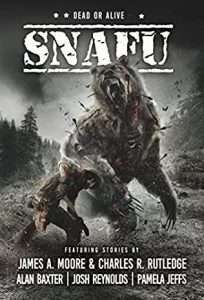 With authors like Reynolds, Moore, Baxter, and Erdelac, and being from Australian anthologists Geoff Brown and Amanda Spedding, I knew I had to have this book. The authors nailed the theme, with plenty of frontier grit, gritty characters, and a wild assortment of horrors to pitch them against. There’s plenty of shootouts, setups that western fans will love, and that SNAFU flavour of desperation, floods of blood and gore, balls-to-the-wall action, and some societal commentary (as all good fiction has).
With authors like Reynolds, Moore, Baxter, and Erdelac, and being from Australian anthologists Geoff Brown and Amanda Spedding, I knew I had to have this book. The authors nailed the theme, with plenty of frontier grit, gritty characters, and a wild assortment of horrors to pitch them against. There’s plenty of shootouts, setups that western fans will love, and that SNAFU flavour of desperation, floods of blood and gore, balls-to-the-wall action, and some societal commentary (as all good fiction has).
As with all anthologies, there were some stories that knocked my expectations out of the park, some I’m happy I read, and some that didn’t land for me. Some of the stand-outs were Hidebehind by Josh Reynolds which had an amazing voice and was brilliantly paced and written, Where Thunder Dwells by Edward M. Erdelac which had a few really engaging POVs (and I think will be a favourite of grimdark fans), and The Battle for Halloway Pass by Richard Beauchamp which is exactly the kind of story SNAFU fans just keep coming back for.
SNAFU: Dead or Alive delivers exactly what SNAFU fans want, with all the horror action you could imagine under a new theme that the authors clearly just embraced. Grab yourself a copy using the links below, and / or keep reading below to see my thoughts on each story.
Read SNAFU: Dead or AliveNotes on the individual storiesBelow were my running thoughts on each story. The scoring system was based on feel-in-the-moment for each short story, and should be taken with a grain of salt, versus a more formal score that would normally be appointed a long-form novel.
Ain’t no Grave by Justin Coates: On the Colorado frontier, Creed and his newly deputised posse chase a band of werewolves into the wilderness, their mission to bring down the Hangman. A pretty decent opener to the book. Wall-to-wall action encased in horror and big guns. Exactly what I picked this book up for. 3/5
Hidebehind by Josh Reynolds: Kemper leads a posse of rough necks into the Appalachian mountains to take down a trouble maker. One last gig for the agency and he’d leave this life of violence and violent men behind. Great voice. Wonderfully paced and written. Once this gets rolling it is completely un-put-downable. 5/5
Patchwork Reaper by Pamela Jeffs: The protagonist is ranging in a non-descript western area, looking for longhorns and men. Finds his boss dead and then runs into an ancient horror. Cool take on the theme, but no real twist or surprise for me. 3/5
Pendulum of Ash by John Coming: Arthur is looking for the tapes, a kind of artefact, when he runs into the most infamous killer in the known world. This story is big on scene setting, massive on history, and winds that beautifully through the story, investing you in the world. Then, it just ends and I can’t help but feel that there was so much more to be said on these pages. A morose ending, that I wish could have been more. 3/5
The shadow under sad hill by Robert Lassen: The Henderson brothers are coming to town. The bells are ringing in alarm and Sherriff Stanton, all six foot, head-to-toe bandaged of him is there to stand in the way. But the Henderson brothers aren’t the only thing the town needs to be afraid of, because beneath Sad Hill lies a shadow far more terrifying. Another excellent story that SNAFU fans are going to love. Action, horror, a great tale by the author. Loved it. 4/5
The Fall of Denfanas Manor by KC Grifant: Melinda is in a stolen stagecoach fleeing from a cursed family. She’s stolen their prize / plaything, a young woman from a local town. With a mercenary crew, hired by the girl’s mum, she’s trying to get the girl home. The action scene /stagecoach chase which made up the opening of this story I just couldn’t get into. The writing style is not for me, and that made the action feel stunted and forced and not fun, for me. 1/5
Parson’s grange by David Benton and WD Galiani: The Bosses’ kid has interrupted Carter and Smokey’s card game to get them to go check on the cattle. In the bloody chaos that follows a Marshall and a local posse must enter a dark forest where something monstrous awaits. Not my favourite style of storytelling from a writing perspective—plenty of telling—and a pretty unconvincing twist means this one wasn’t for me. 2/5
The Fiends of Turner’s Creek by Alan Baxter: Clyde and his son have heard there’s good prospecting in a frontier town. The discovery of a dismembered body in the surrounding bushes doesn’t quite blunt their enthusiasm, but soon something will. A fun, old school action romp from start to finish. Smartly planned out and delivered. A definite page turner. 4/5
Where Thunder Dwells by Edward M. Erdelac: Haayashi’s pleasant customer interaction with the cavalryman is spoiled by Snaker and his Pista gang as they burst into her store. Out of town, Ves sees fire on the horizon and joins a posse to take down the Pista Gang. One of the really interesting things about this western is that the two POVs aren’t of European descent—only everyone in between is. An absolute magic story of multiple POVs. Plenty of horror. Plenty of action. Plenty to like for a grimdark fan. 4.5/5
Mercy by John W. Salvage: Barrett Tanner of the Brotherhood investigates the supernatural. One of his brotherhood brethren has been killed, and he’s riding into the town of Mercy to find out why. This story had a super strong start that I really enjoyed, but petered out towards the end. 3.5/5
Snake Men on a Train by James A. Moore and Charles R. Rutledge: Ben Logan sits on a train with a fellow guard, heading into the fog when the train comes to a halt. Outside, rocks and boulders lay over the tracks ahead, and a body torn to shreds lays on the wayside. Cool idea, but just didn’t carry me through the story. Felt like a lot of telling, and that’s just not my jam. 2/5
Unfinished Business by Benjamin Spada: Woods has been contracted to kill a man. For the second time. A dip into a near future western frontier. Fun, different and differentiated from the other stories. 3.5/5
Hot blood and iron by Sharon Gray: Alice’s town has been destroyed, the people rounded up and some killed. Amongst them is her best friend—murdered by demons shaped as men. A nice take on the very standard western tale of bad guys come to town, provide ultimatum, and a big fight ensues. No real twist in the ending to get my teeth into, though. 3/5
The Goodnight Trail by John Paul Fitch: Jacob and his brother Isaac are part of a wagon train driving a couple thousand head of cattle up the Goodnight Trail. They stop for the night at an abandoned fort. It’s pretty peaceful. A scream in the night changes all that. The horror aspect of this is really well done, the last stand approach as well. There were some moments throughout—important moments—I don’t think landed very well in their intended emotional intensity. 2.5/5
The Battle for Halloway Pass by Richard Beauchamp: Otis is opening the mine cap on the last part of Bear Horn Mountain, where three generations of miners have avoided due to fear of the whispers coming from within. A wonderful story to read and exactly the kind of thing you read the SNAFU anthologies for. 4.5/5
Six Guns and Sorcery by Nathan E. Meyer: In a frontier town 20 years after the US civil war, Quill and Six Kills are on a mission to save Quill from an unavoidable, slow, and relatively horrible death. A decent story that felt a bit too long for the actual meat in it. 3.5/5
The post REVIEW: SNAFU: Dead or Alive appeared first on Grimdark Magazine.
January 3, 2023
REVIEW: No Heart for a Thief by James Lloyd Dulin
No Heart for a Thief is the introspective dark fantasy debut from indie author James Lloyd Dulin and the first entry in his Malitu series.
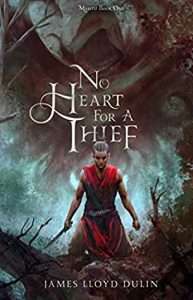 The novel opens with a bang as Kaylo, an aging thief and self-described spirit dancer, rescues a fourteen-year-old girl, Tayen, from enemy soldiers who murdered her family. Tayen soon recognizes Kaylo as the famous but reclusive Hero of Anilace, also known as Ennea’s Thief. But Kaylo feels unworthy of such glorious titles and assumes personal responsibility for the ongoing war between Ennea and the invading Gousht Empire. Kaylo’s solitary existence comes to an end as he reluctantly becomes mentor and guardian for the orphaned Tayen.
The novel opens with a bang as Kaylo, an aging thief and self-described spirit dancer, rescues a fourteen-year-old girl, Tayen, from enemy soldiers who murdered her family. Tayen soon recognizes Kaylo as the famous but reclusive Hero of Anilace, also known as Ennea’s Thief. But Kaylo feels unworthy of such glorious titles and assumes personal responsibility for the ongoing war between Ennea and the invading Gousht Empire. Kaylo’s solitary existence comes to an end as he reluctantly becomes mentor and guardian for the orphaned Tayen.
The plot of No Heart for a Thief is told on two timelines. Although the novel opens with the present-day story of a middle-aged Kaylo protecting and training Tayen, most of No Heart for a Thief consists of Kaylo narrating his backstory to Tayen. Kaylo’s story is full of tragedy for which he feels personal responsibility. The passing of eighteen years has not healed his emotional wounds or lessened his sense of guilt.
Kaylo tells Tayen of his own training as a boy discovering his powers as a spirit dancer, i.e., an Ennean who has the ability to hear The Song and wield the power of one of the Great Spirits. There are seven Great Spirits of Ennea: The Shadow, The River, The Flame, The Mountain, The Wind, The Seed, and The Thief. Each of the Great Spirits can bestow magical abilities on their spirit dancers. The Thief is the most controversial of the spirits, known for her pursuit of power or equity, depending on one’s perspective. Her gift is to borrow the magical powers of the other spirits.
Despite the epic scale of the war between Ennea and the Gousht Empire, the focus of No Heart for a Thief is very personal. Kaylo’s coming-of-age backstory reveals the connections between his history and the more recent events in Tayen’s life. One of my favorite parts of No Heart for a Thief is seeing the bond develop between these two unlikely companions. I wish that more pages had been devoted to this present-day story.
The intertwining nature of religion and magic is a highlight of No Heart for a Thief. James Lloyd Dulin contrasts the polytheistic religion of Ennea with the monotheistic beliefs of the Gousht Empire, who as colonizers seek to impose their religion on the Ennean people, instructing them in the ways of their One True God. The intersection of the Ennean and Gousht belief systems also forms the basis for a rather surprising plot twist late in the novel. Dulin leverages this twist to give a satisfying conclusion to No Heart for a Thief while also setting up nicely for the next volume of the series. However, I was hoping for more moral complexity among the Gousht Empire, who serve as classic epic fantasy villains.
Overall, No Heart for a Thief is a solid debut from James Lloyd Dulin and recommended for fans of introspective character-driven fantasy with innovative magic systems.
4/5
Read No Heart for a Thief by James Lloyd DulinThe post REVIEW: No Heart for a Thief by James Lloyd Dulin appeared first on Grimdark Magazine.
January 2, 2023
REVIEW: Blade Runner ‘Black Lotus’ #2 by Nancy Collins and Enid Balám
Blade Runner ‘Black Lotus #2 is the second installment of the miniseries sequel to the popular Cartoon Network anime starring Jessica Henwick and WIll Yun Lee. Set between the two Blade Runner movies, it follows the adventures of a specially designed Replicant named Elle. The anime was enjoyable but had some questionable animation and a somewhat action heavy plotline versus character development.
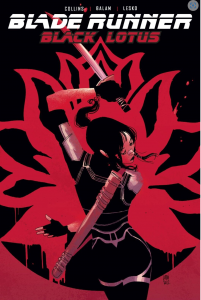 After a somewhat rocky start, this issue jumps into the action and is almost entirely combat from beginning to end. In this case, the settlers that Elle is living with are attacked en masse by the mercenaries of the fracking plant that powers Fracktown. The story takes a sudden swerve into darker territory than expected as the attack is motivated by human trafficking. Yes, the Fracktown folk want to kidnap a bunch of women and use them as sex slaves for the miners due to the lack of Replicant women to abuse after Niander Wallace cancelled their contract.
After a somewhat rocky start, this issue jumps into the action and is almost entirely combat from beginning to end. In this case, the settlers that Elle is living with are attacked en masse by the mercenaries of the fracking plant that powers Fracktown. The story takes a sudden swerve into darker territory than expected as the attack is motivated by human trafficking. Yes, the Fracktown folk want to kidnap a bunch of women and use them as sex slaves for the miners due to the lack of Replicant women to abuse after Niander Wallace cancelled their contract.
I have to say I was surprised the comic would get this dark despite Blade Runner routinely dealing with issues of Replicant slavery. The fact the art style remains somewhat cartoony, fitting the anime origins of the character, is something that contrasts poorly with this revelation. On the other hand, I have to say that at least it provides some stakes that had previously been absent from the book. With only four issues, having Elle need to go rescue a bunch of women kidnapped by the crooked oil riggers is at least a goal.
The book’s aethstetic remains more Wild West and post-apocalypse than cyberpunk, which is something that I’m reasonably okay with. As a big fan of Fallout, seeing the scavenger society in the wastelands outside of Los Angeles was something that may not immediately inspire one to think of Blade Runner but it at least is a recognizable genre for our heroine to participate in. Sadly, with half of the series already over, it seems clear this is going to be mostly a side story with little real development in Elle’s story.
One element I do appreciate is that a character among the settlers is revealed as a Blade Runner. With no few ties to the main series, it’s nice to incorporate some more into the story. The fact that she just randomly stumbled over one of the profession stretches credibility, though. It just makes me think the story would have benefited from including Joseph instead. It’s still better than not incorporating that element in the story, though.
In conclusion, I still very interested in where the story is going and am glad that we’ve introduced the main “plot” for the four-issue story. The art style remains a bit too cartoonish for the style of story they’re telling but the action was well done.
Read Blade Runner ‘Black Lotus’ #2 by Nancy Collins and Enid BalámThe post REVIEW: Blade Runner ‘Black Lotus’ #2 by Nancy Collins and Enid Balám appeared first on Grimdark Magazine.
January 1, 2023
REVIEW: Necromunda: Hired Gun
In Necromunda: Hired Gun you play a bounty hunter in a colossal hive city on the planet of Necromunda in the Warhammer 40,000 universe. With its gorgeous gritty city landscape showcasing the Doom-style mass closed environment battles, there is plenty to enjoy here for the mayhem-style FPS fan.
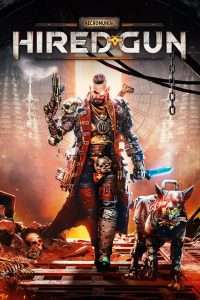 The scenery in Necromunda: Hired Gun is utterly gorgeous, and the hive city you play in is beautifully detailed and put together, with the religious fanaticism of the Mechanicus and the horrible toxic plight of the Imperial citizenry on full display in every nook and cranny. The way this is then graffitied over by the gangs in control of each area you venture in to provides the really well lived-in historical feel—the way it should be with a city thousands of years old and thousands of levels deep.
The scenery in Necromunda: Hired Gun is utterly gorgeous, and the hive city you play in is beautifully detailed and put together, with the religious fanaticism of the Mechanicus and the horrible toxic plight of the Imperial citizenry on full display in every nook and cranny. The way this is then graffitied over by the gangs in control of each area you venture in to provides the really well lived-in historical feel—the way it should be with a city thousands of years old and thousands of levels deep.
The weapons are plentiful, and there are plenty of upgrades and customisations to make them suit your gameplay and aesthetic preferences. Your cyber mastiff is also a pretty awesome addition—a short term side-kick that you can upgrade as you go, and a character that is super helpful in getting you out of a bind.
The gameplay is very much in the same vein as a Doom, Quake, or Wolfenstein, with plenty of jumping, double-jumping, wall running and running around to avoid storms of bullets and missiles from hordes of gang members (when some massive ogryn or gang leader isn’t lightning-leaping across the room to punch your head in). And when you understand that part of the game–what it is at its core–it makes progression through the missions a whole lot easier.
The health system in Necromunda: Hired Gun is also something I appreciated. The constant dropped refractor shield recharges from killed enemies and the health boosts you get from certain kills, plus a post-death regeneration system that I found very forgiving, make it easy and fun to keep rolling through the levels and the mayhem.
The music score is also just fucking awesome. Metal music for a metal underhive being coated in blood by metal clad gangs. So spot on. A little tricksy when you start mentally attaching the music to combat and all of a sudden you get attacked without music and you are just wondering why we can’t be friends when the music isn’t raging, but there you go.
There are a few things with this game that didn’t land for me, however. I will preface the following with that I provide this feedback as a person with less-than-average gamer capability who just loves games for the story, visuals, and action whenever I can get a few hours to play them. So for those of you who can obsess and sink hundreds of hours into a game no worries: take this with a grain of salt if needed.
My biggest issue with Necromunda: Hired Gun was the mission design.. The first scene sets you up on the tail of the deadly Silver Talon, and then, in the time that I played it, kind of just fritters around from there. There were missions and mission sections that finished when honestly I’m not sure what I did or who I killed to make the mission end. Then those missions’ relation to the relatively watery storyline anchored on a partnership with old school Necromunda legend NPC Kal Jericho also seemed pretty flimsy for the time I played this game to write this review (~10hrs). With such a massive stable of authors working for Games Workshop and Black Library, this is actually the part that surprised me the most.
In addition there was a catch-22 boss in there relatively early, where I found myself in a more narrow storyline section, not allowed to get back to HQ to level up or get better weapons, nor was I equipped with stims to survive or the right guns to take on the boss. Normally, for the layperson gamer like myself, this creates an unwinnable rage-quit point that I really think should not be in the early stages of games. These parts in video games represent the first 20% of a book, in my mind; if you can’t get somebody in and keep them in early, they are likely to stop playing and miss all the awesome stuff you planned for them later.
I also don’t know the kind of demand on my Xbox that it would have required, but keeping some of the bodies and machines you kill in the environment would have been a solid effect. In addition, when in fights with bosses and characters that have a tagline, by the end of the fight I’m more sick of the tagline than I am of killing the exact same character over and over again (eg. “Die, you throne damn skinny!” Gets real old the 150th time you’ve heard it in a four minute battle).
Necromunda: Hired Gun is an utterly stunning game that completely immerses you in the 40k universe, but might have benefitted from a Gears of War style combat system with a little less chaotic mayhem, and a little more use of that gorgeous scenery.
Play Necromunda: Hired GunThe post REVIEW: Necromunda: Hired Gun appeared first on Grimdark Magazine.
December 31, 2022
REVIEW: The Fade Out: The Complete Collection by Ed Brubaker and Sean Phillips
The Fade Out: The Complete Collection by Ed Brubaker and Sean Phillips, illustrated by Elizabeth Breitweiser is not my usual grimdark fair. However, grimdark is the fantastic cousin to film noir and detective fiction. Much like in my LA Noire review, the subject matter deals with Los Angeles in the 1940s. It is a fantastic time to write stories about because the glamour and sleaze of Hollywood contrasts with the post-World War 2 trauma as well as economic boom.
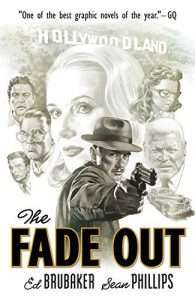 The Fade Out is a twelve issue comic book series that I recommend people just purchase the complete collection of rather than the three individual parts. The story works extremely well as a single narrative and quite a lot of jokes as well as clues dropped in the earlier books find payoff later in the story. It is a fantastic read from beginning to end that has some elements that need to be warned about for readers but, otherwise, is one of my favorite reads for 2022. Hell, despite reading it in December, it may be my favorite read of 2022.
The Fade Out is a twelve issue comic book series that I recommend people just purchase the complete collection of rather than the three individual parts. The story works extremely well as a single narrative and quite a lot of jokes as well as clues dropped in the earlier books find payoff later in the story. It is a fantastic read from beginning to end that has some elements that need to be warned about for readers but, otherwise, is one of my favorite reads for 2022. Hell, despite reading it in December, it may be my favorite read of 2022.
The premise is Charles Parish is a World War 2 veteran who has come back completely dry of ideas as a Hollywood screenwriter. PTSD (or shell shock as it was known then) has robbed him of his creative juices. He has delegated all of his writing, instead, to blacklisted fellow screenwriter Gil Mason. Gil is an alcoholic with a self-destructive streak who told Charles to name him to the House Unamerican Activities (HUAC) board in order to save the latter’s career. No one knows this and Charles is considered a pariah by Gil’s old friends despite the fact he’s the only reason the man still has an income.
This already interesting premise is supplemented by the fact that Charles goes home with a beautiful starlet one evening, having both gotten inebriated at a party for a rich friend, and wakes up to her horrible murder. Unable to deal with the possibility that he could be implicated in their death, he covers up his presence and heads out the door. The next morning, he finds out her death has been labeled a suicide (despite clearly not having been) and the studio’s primary concern being that her picture be finished.
What follows is equal parts murder mystery and examination of the decadent controlled world of 1940s Hollywood. A place where the mores of society are completely cast aside behind doors but you are subject to total control of the dying studio system. Where the only thing that had threatened the studios in recent years was the power of the federal government and for nonsensical charges. After all, if there’s any more capitalist place on Earth with its worship of wealth, fame, and power then I point out Las Vegas is still in its infancy.
Charles is an interesting protagonist because he’s not technically trying to solve the starlet, Val’s, murder. For the most part, he’s trying to shove the event under the proverbial rug and forget about it but can’t bring himself to do it. If Charles has any unbelievable qualities, it’s the fact that the female cast seems to trip over themselves in order to sleep with him. Gil’s wife, the studio PR head, Val’s replacement on the picture, and even a singing cowboy picture dancer are among those who want our Peter Parker-esque antihero.
Which does get to one element that is noticeable in this book and that is the copious fanservice and nudity. Ed Brubaker takes advantage of the lack of censorship at Image comics and Elizabeth Breitweiser’s skill at rendering characters to throw quite a lot of it at the reader. It’s noticeable enough to be distracting but nothing that couldn’t be shown on HBO were it to be adapted to a miniseries. Speaking of the art, the realism of the work is amazing and I really felt I was watching a film in print form.
Much of the story also takes time to share horrible stories from real life Hollywood and the utter ridiculousness of it all. Some of the stories are touching like Clark Gable’s insistence on volunteering for WW2 and Dashiell Hammett’s raising money for blacklisted Hollywood figures. Others are more disturbing like the fact a studio director had honest-to-goddess SECRET PASSAGEWAYS installed into the closets of the dressing rooms of his starlets. Apparently, Betty Davis almost stabbed him one time.
Indeed, sometimes the characters that Ed Brubaker introduces are toned down versions of their real life counterparts. Phil Brodsky is a Hollywood fixer who beats up the boyfriends of gay Hollywood stars, bribes people to look the other way, and is otherwise repulsive. However, he has nothing on Eddie Mannix the real life personage who possibly murdered George Reeves, star of the Superman television show.
The supporting cast is great for the book as well with a number of extremely interesting characters both good, bad, and somewhere in between. I don’t go with the idea a character is “believable” in my fiction but I feel like all of these characters are authentic with many layers. Even the fixer, Brodsky, has some lines that he won’t cross as a studio enforcer.
The ending, oof, is pretty bleak and perfect for grimdark fans. Just be warned it’s a real gut punch. If you liked LA Confidential, The Black Dahlia, LA Noire, or Mulholland Drive then this is the kind of comic book for you. It is dark, well-written, and full of twists. It may be my favorite comic by Ed and he created the Winter Soldier.
Read The Fade Out: The Complete Collection by Ed Brubaker and Sean Phillips, illustrated by Elizabeth BreitweiserThe post REVIEW: The Fade Out: The Complete Collection by Ed Brubaker and Sean Phillips appeared first on Grimdark Magazine.
December 30, 2022
REVIEW: The Ocean at the End of the Lane by Neil Gaiman
Sometime during the course of growing up, we lose that connection to the magic of childhood. It’s a loss of innocence and imagination that seems to happen gradually. By the time we realize it’s gone, it’s too late to recapture. The Ocean at the End of the Lane eloquently captures the wonders of childhood in this surprisingly dark novel from Neil Gaiman.
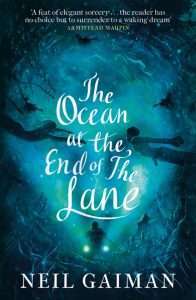 The Ocean at the End of the Lane opens with the adult narrator returning to his childhood home for a funeral. His childhood memories are rekindled during his visit home, especially in relation to a neighbor girl with whom he played as a child.
The Ocean at the End of the Lane opens with the adult narrator returning to his childhood home for a funeral. His childhood memories are rekindled during his visit home, especially in relation to a neighbor girl with whom he played as a child.
Childhood memories have a magical quality to them. Everything seemed bigger as a child, and there seemed to be a touch of magic to the unexplainable phenomena of the world. Is that pond at the end of the lane really an ocean? Or did it just seem that way as a child?
Neil Gaiman is in absolute peak form in this beautifully told story about reconnecting with the magic and imagination of childhood. The Ocean at the End of the Lane is told like a fairy tale, because that’s what childhood is, isn’t it?
This is a story of friendship and sacrifice, a story of lost innocence, and a story of the wondrous power of imagination. The narrator gradually discovers that his childhood memories may not be what they seem.
The Ocean at the End of the Lane is also surprisingly dark, including a scene where the narrator extracts a magical worm from his foot that will make even the darkest of grimdark fans squirm.
I can’t think of another book that captures the magic of childhood so beautifully, evoking so many emotions of wonder and excitement, of love and loss. Five very enthusiastic stars for this dark and magical masterpiece that is The Ocean at the End of the Lane.
5/5
Read The Ocean at the End of the Lane by Neil GaimanThe post REVIEW: The Ocean at the End of the Lane by Neil Gaiman appeared first on Grimdark Magazine.
REVIEW: Death’s Beating Heart by Rob J. Hayes
Picking up just moments after the ending of Sins of the Mother, Death’s Beating Heart brings us at last to the conclusion to The Eternal War.
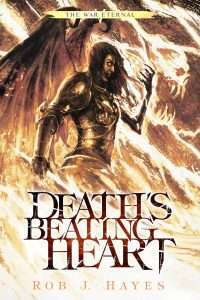 Eskara Helsene has come out of retirement to help fix the mess that her daughter has caused. Sirileth has brought down one of the moons in order to prevent The Maker from entering their world. While this event saved Ovaeris from that terrible fate, slamming a moon down onto the planet tends to bring catastrophic results to most of it. Saving everyone from one disaster has only opened it all up for another.
Eskara Helsene has come out of retirement to help fix the mess that her daughter has caused. Sirileth has brought down one of the moons in order to prevent The Maker from entering their world. While this event saved Ovaeris from that terrible fate, slamming a moon down onto the planet tends to bring catastrophic results to most of it. Saving everyone from one disaster has only opened it all up for another.
The funny thing about choosing the lesser of two evils; it’s still evil, and still enough to damn you.
Sirileth’s actions have opened a portal to the parallel world of Sevorai, where Eskara’s ancient horror originates. That’s the good news. What’s very horribly bad is that that world is being consumed by Norvet Meruun, also known as Death’s Beating Heart. Now that the portal is open, Eska’s world is now in the path to be consumed as well.
The Corpse Queen has to unite the leaders of the world to face this Beating Heart before it is too late. Problem is, the previous four books in this series have given everyone many reasons to distrust Eska and hesitate to grant her an audience.
There is perhaps no faster way I know of to lose someone’s trust than to tell them to trust you.
Of course, Eska aka The Corpse Queen is now officially retired, and the current queen of Yenheim is Sirileth, who just brought down the moon. The two of them together can surely convince the leaders of their continent to give their support, right? What could go wrong?
Still, evil looks and angry whispers are always better than thrown rocks and mbs with murder on their mind.
This was a great conclusion to the War Eternal and the story of Eskara Helsene. What began in Along The Razor’s Edge has brought the steady reader along on a life long journey, told from the perspective of what most would consider the world of Ovaeris’s premier villain. It has been a lot of fun, and this reader in particular will miss getting in Eska’s head and dealing with a world that fears her. It’s a great character study to get into the head of what most would consider a villain and see their true motivations.
Read Death’s Beating Heart by Rob J. HayesTrust me, I have unwoven enough ghosts to know that most of those who believed they died glorious deaths would much rather have lived long, unfruitful lives.
The post REVIEW: Death’s Beating Heart by Rob J. Hayes appeared first on Grimdark Magazine.
December 28, 2022
Review: The Burning God by R.F. Kuang
The Burning God is R.F. Kuang’s epic finale to her Chinese history-inspired Poppy War series, which began with The Poppy War and continued with The Dragon Republic.
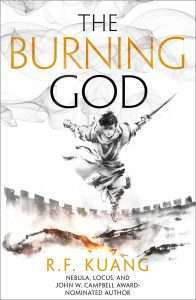 It’s impossible to overstate what R.F. Kuang has accomplished with the Poppy War trilogy. She has reinvented grimdark fantasy with her magical world that parallels the real-world events in Chinese history, most notably the Opium Wars, World War II, and the Communist Revolution.
It’s impossible to overstate what R.F. Kuang has accomplished with the Poppy War trilogy. She has reinvented grimdark fantasy with her magical world that parallels the real-world events in Chinese history, most notably the Opium Wars, World War II, and the Communist Revolution.
This series is honest and brutal. The characters are all deeply flawed, and the main protagonist, Rin, is an anti-hero of the highest caliber. Rin is somehow a sympathetic character while simultaneously committing the most atrocious of war crimes.
In The Burning God, the series reaches its emotional and violent climax. The plot parallels that of the Chinese Civil War. Rin is a stand-in for Communist leader Mao Zedong, coming from the peasant class and leading a revolution of the peasants against the aristocracy. Nezha and his father are stand-ins for Chiang Kai-Shek and the Nationalists.
The violence of the war is surpassed only by the misery and famine that the war leaves in its wake. Rin may be good at waging war, but like Mao she is completely inept as a post-war leader.
I know this is nitpicking, but I have just a few minor quibbles with The Burning God. The geography as described in the book is inconsistent with the geography as depicted in the map. I tried to make sense of it, but ultimately gave up and decided to just go with the flow of the novel.
Also, the role of opium in accessing the power of the gods is inconsistent. Sometimes it helps characters access magical powers, and sometimes it prevents them from doing so. Also, when Rin trains new students in the magical arts, it seems way too easy for them to learn compared to how Rin had to learn in the first volume of the trilogy.
Notwithstanding these minor quibbles, The Burning God is an excellent book, and the trilogy as a whole is a masterpiece. Decades from now, I’m sure that R.F. Kuang’s Poppy War trilogy will prove to be one of the most influential fantasy series of the modern era.
If you haven’t already finished the Poppy War trilogy, be sure to read The Burning God now. But make sure you don’t have anything else on your calendar, because you won’t be able to put it down.
4.5/5
Read The Burning God by R.F. KuangThe post Review: The Burning God by R.F. Kuang appeared first on Grimdark Magazine.
December 27, 2022
REVIEW: Carmilla by J. Sheridan Le Fanu
Carmilla by J. Sheridan Le Fanu is the one of the first great works of vampire fiction, published in 1872, about a quarter century before Bram Stoker’s Dracula. Like the undead titular character, Carmilla is a timeless work, brimming with vivacity and an irresistible yet dangerous allure.
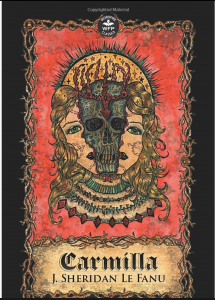 The teenaged narrator, Laura, lives with her father in an old Austrian castle. As a six-year-old girl, Laura dreams of a young woman looking over her at night, a singular beauty whom she cannot erase from her mind. Upon waking from her dream, she discovers a mysterious pain in her chest.
The teenaged narrator, Laura, lives with her father in an old Austrian castle. As a six-year-old girl, Laura dreams of a young woman looking over her at night, a singular beauty whom she cannot erase from her mind. Upon waking from her dream, she discovers a mysterious pain in her chest.
Many years later, a carriage breaks down in front of their castle, and the family is left to take care of a beautiful girl, Carmilla, who appears to be the same age as Laura. Laura and Carmilla immediately recognize each other from their childhood dreams, and a close-knit friendship blossoms. This friendship soon crosses over to romantic courtship as Carmilla’s desires grow more carnal.
Meanwhile, girls across the village are succumbing to a mysterious illness, unexplainable by any natural means. The locals believe that the girls are becoming sick through supernatural means and are determined to put an end to this evil.
Carmilla is an early masterpiece of Gothic fiction, setting the standard for vampire fiction for 150 years after its publication, and its influence has only grown in recent years. Personally, I enjoyed Carmilla a lot more than Dracula, which seems rather stodgy by comparison. Sheridan Le Fanu should also be commended for his natural and non-judgmental depiction of sapphic love, which is surprising for something published in the nineteenth century.
Overall, Carmilla is a must-read for lovers of Gothic fiction and vampire horror. Sheridan Le Fanu’s classic novella is somehow just as vibrant today as when it was published in 1872.
4.5/5
Read Carmilla by J. Sheridan Le FanuThe post REVIEW: Carmilla by J. Sheridan Le Fanu appeared first on Grimdark Magazine.
December 26, 2022
REVIEW: Blade Runner ‘Black Lotus’ #1 by Nancy Collins and Enid Balám
I was a big fan of Blade Runner ‘Black Lotus’ when it appeared on the Cartoon Network. As a massive fan of Jessica Henwick and Blade Runner 2049, I was able to overlook the anime’s somewhat spotty animation and issues storytelling wise to appreciate it as an action-heavy intequal between the movies. Unfortunately, I felt the ending was somewhat too ambiguous with a lot of unresolved plot threads that needed to be followed up on.
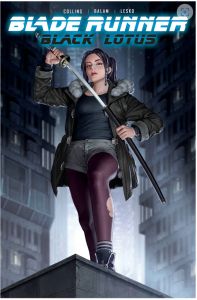 So I was very excited about the prospect of a sequel comic that would follow up on the plot of Elle as well as perhaps answer some of those lingering questions. Given how much I enjoyed the other Blade Runner comics, I was also certain they could capture the full enjoyment factor from the cartoon and possibly improve on it.
So I was very excited about the prospect of a sequel comic that would follow up on the plot of Elle as well as perhaps answer some of those lingering questions. Given how much I enjoyed the other Blade Runner comics, I was also certain they could capture the full enjoyment factor from the cartoon and possibly improve on it.
Did it succeed?
Yes and no.
Blade Runner: Black Lotus #1 starts with seeming confirmation that Joseph from the anime did, in fact, die rather than survive to rejoin Elle in the desert like many of speculated. I feel this is something that hangs over the story since Joseph was one of the most interesting characters in the series and his developing relationship with Elle was something we all wished to see continued.
The rest of the comic also takes a sharp dive from typical Blade Runner aethstetics and even cyberpunk. Elle takes refuge in the desert and ends up in “Fracktown”, which seems more like something from Mad Max or Fallout rather than the rain soaked high tech world of Los Angeles in either movie. Indeed, it only takes a little while to realize that this is going to be a cyberpunk Western with the conflict being between the salt-of-the-Earth settlers and the man running a fracking operation.
I’m not sure what to make of a Western cyberpunk story as while I’ve enjoyed a few in the past like Sean Connery’s Outland, it is definitely something unexpected in a Blade Runner story. Niander Wallace still seems like he’s interested in Elle and asserts his influence over the local boss by insisting on his property (Replicant pleasure models) being better treated but if there’s a larger goal from the man, it is kept a secret.
The art is acceptable but is hard not to compare with the other Blade Runner comic art and comes up a bit short. It has an anime-esque style that reminded me most of the Avatar: The Air Bender comics, though a bit blockier. Overall, I’m going to say that I’m intrigued and interested in reading the rest of the series but wish they’d stuck to a bit more cyberpunk style and certainly kept Joseph alive.
Read Blade Runner ‘Black Lotus’ by Nancy Collins and Enid BalámThe post REVIEW: Blade Runner ‘Black Lotus’ #1 by Nancy Collins and Enid Balám appeared first on Grimdark Magazine.



